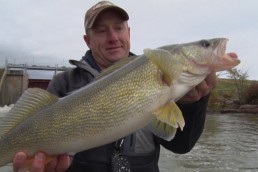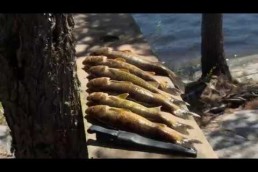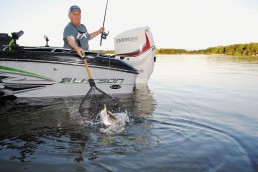Catch a Big Smallies, from Northern Wisconsin Waters
SHARE THIS POST
In recent years, areas of northern Wisconsin have not only been producing smallmouths, but also some very large specimens. Smallmouths near the state-record size have been measured, weighed, photographed and released.
Some of these bruiser-sized bass are coming from the many flowages across the northern part of the state. These brackish- colored waters are full of stump fields, river channels, laydowns, rock bars and creek channels and even old flooded lakes, which are inside the flowages, providing spawning and ambush-feeding locations and deep-water winter sanctuaries.
There are many other clear- and dark-water lakes with smallmouths. Many of these produce numbers of fish with the occasional mule-sized smallmouth bass. This is no different than all the good muskie lakes throughout the area. These waters have a two-week variation on spawning. This may not sound like a big difference, but this is a location- and weather-related issue that takes place every spring. Some natural tea-colored lakes with a lot of islands also have large numbers of 1 1/2- to 2 1/2-pound bass but, only the occasional “big͇” one.
When we are fishing the dark-water flowages or natural lakes, sight fishing for the bass on the shoreline is simply out of the question. The water is normally so dark that we cannot see them swimming close to shore as we can on clear-water lakes.This can create a serious problem for some. What usually happens is many will cast along the endless shorelines until they catch a couple of fish. Using this method is good, only if you have a lot of time on your hands.
Locating certain high-percentage spawning areas has been made easier today with mapping technology. In slow-moving flowages, we may not want to go the farthest backwater we can find hoping to locate where the bass are staying out of the current to spawn. And going far back and away from the creek channels in shallow water is not always a good idea, as the oxygen levels are low.
Looking for a flat area that is next to a creek channel is a good option—the down side of the current where there is a sand bar sticking off the creek channel, or where there is a flat coming off the shoreline reaching the creek channel. The channel will support most of the life during winter until the fish start moving out or in the deep-water areas for the spring spawn. The list of locations is long, and locating them on our maps or electronics can give us the best, educated guess to get started. Most of the islands in locations as well can produce well, especially if there is a sand or rock bar connected to that island.
Are you enjoying this post?
You can be among the first to get the latest info on where to go, what to use and how to use it!
On the clear-water lakes, we immediately look for the flats connected to the shoreline that protrude out into the lake. Long, tapering points that extend out into the lake are also a good bet. And a shallow bay that extends out into deep water works well too.
Rock piles way out in these deep lakes do not produce as well in early or late spring. The water surrounding the rock piles can be too cold and the bass are searching out the warmer waters. Small inlets are a good, and if some are on the west side of the lake, all the better. If certain lakes have cisco or white fish, hold on tight, because can be some jumbo-sized, record- breaking smallmouths waiting for you.
Smaller bait in the spring or late in this season work best. Finding the fish and casting to them works well when on a clear-water lake. Casting a long distance on shallow bars or flats is also effective in early June.
We no longer have to go only in summer to the Great Lakes for big bass. There are dozens of lakes and flowages full of the mule-sized smallmouths right here in Wisconsin. MWO
MWO
SHARE THIS POST
Did you enjoy this post?
You can be among the first to get the latest info on where to go, what to use and how to use it!
John Andrew
John Andrew is the owner/operator of The Anglers Choice Guide Service located in northern Wisconsin. He may be reached at 715-892-3020, 715-686-2012 or johnandrew@centurytel.net or theanglerschoiceguideservice.com.


